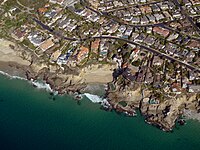
Photo from wikipedia
ABSTRACT Digital elevation models (DEMs) have been increasingly applied in topographic studies in areas such as physical geography and hydraulic engineering. Several methods have been proposed to reconstruct DEMs, including… Click to show full abstract
ABSTRACT Digital elevation models (DEMs) have been increasingly applied in topographic studies in areas such as physical geography and hydraulic engineering. Several methods have been proposed to reconstruct DEMs, including classic close-range stereo photogrammetry and the more novel Structure from Motion (SfM) methodology. Past published studies tend to apply SfM to large-scale environmental processes, whilst classic close-range stereophotogrammetry is focusing on detailed small-scale applications. However, SfM requires multiple ground control points (GCPs) to allow for proper DEM scaling. The larger the study area, the more GCPs are required, resulting in increased operational complexity and time-consuming application of SfM. As the accuracy of the DEM depends on the equipment used to measure GCPs, this can also result in a cost-expensive operation. In the present study, we introduce a combined SfM and close-range stereo photogrammetry application, with the close-range stereo photogrammetry results serving as a control for providing scale, thus eliminating the need for traditional GCPs. To validate our methodology, we studied a 40 m long gravel bar. We used GoPro Hero 3 cameras for SfM measurements and replaced GCPs by DEMs obtained through close-range stereo photogrammetry with a Nikon D5100 camera pair in stereo. In addition to using photo-mode frames, we also studied the quality of DEMs obtained with GoPro Hero 3 video-mode frames, and show how the DEM quality is reduced due to the smaller image format, hence coarser point cloud spacing, which eventually results in a convex curvature when image overlap was increased. Our results show that it is possible to collect high-quality topographic surface data by only using cameras, and alleviate the need for GCPs. The proposed workflow reduces the complexity, time, and resource demands associated with deploying GCPs and necessary independent geo-referencing, ensuring that digital photogrammetry will continue to gain popularity for field surveying.
Journal Title: International Journal of Remote Sensing
Year Published: 2018
Link to full text (if available)
Share on Social Media: Sign Up to like & get
recommendations!